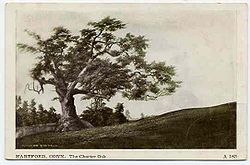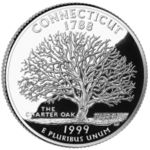- Charter Oak
-
For other uses, see Charter Oak (disambiguation).
 The Charter Oak, oil on canvas, Charles De Wolf Brownell, 1857. Wadsworth Atheneum
The Charter Oak, oil on canvas, Charles De Wolf Brownell, 1857. Wadsworth Atheneum
The Charter Oak was an unusually large white oak tree growing, from around the 12th or 13th century until 1856, on what the English colonists named Wyllys Hyll, in Hartford, Connecticut, USA. Its name derives from its importance as a legendary symbol of American independence (specifically, autonomy from England) from the story of how Connecticut's constitutional charter had been hidden within the hollow of the tree to thwart royal-ordered confiscation by English authority. This document is what earned Connecticut its nickname as the Constitution State, and the Charter Oak is commemorated on the Connecticut State Quarter.
Contents
Early history
The Dutch explorer Adrian Block described, in his log in 1614, a tree, at the future site of Hartford, understood to be this one. In the 1630s, a delegation of local Indians is said to have approached Samuel Wyllys, the early settler who owned and cleared much of the land around it, encouraging its preservation and describing it as planted ceremonially, for the sake of peace, when their tribe first settled in the area. Scions of the tree still grow in Hartford.
“ It has been the guide of our ancestors for centuries as to the time of planting our corn; when the leaves are the size of a mouse's ears, then is the time to put the seed into the ground.[1] ” Charter Oak incident
The name "Charter Oak" stems from the local legend in which a cavity within the tree was used in late 1687 as a hiding place for the Constitution charter. The oak was then blown down in a violent storm about 150 years later and made into a chair that is now displayed in the Hartford Capitol Building.
This much regarding the charter is history:
- King Charles II, in 1662, granted the Connecticut Colony an unusual degree of autonomy.
- His successor, James II, consolidated several colonies into the Dominion of New England, in part to take firmer control of them.
- He appointed as governor-general over it Sir Edmund Andros who stated his appointment had invalidated the charters of the various constituent colonies, and presumably seeing symbolic value in physically reclaiming the documents, went to each colony to collect them.
- Andros arrived in Hartford late in October 1687, where his mission was at least as unwelcome as it had been in the other colonies.
According to the dominant tradition, Andros demanded the document and it was produced, but during ensuing discussion, the lights were doused, concealing the spiriting of the parchment out a window and thence to the Oak by Captain Joseph Wadsworth, ancestor of Elijah Wadsworth.
Two seldom cited documents, one contemporaneous and one from early in the next century, raise less dramatic possibilities, by suggesting that a parchment copy had been made of the true charter as early as June, in anticipation of Andros's arrival:
- It has been suggested that the copy was surreptitiously substituted for the original (and the original secreted in the oak lest Andros find it in any search of buildings), and that Andros left believing he had succeeded.
- Logically, such a copy (whether hidden in the oak or not) might instead have been the one kept, for the value it might have in propaganda, for morale, or in petitioning for its reinstatement.
The Museum of Connecticut History (a subdivision of the Connecticut State Library) credits the idea that Andros never got the original charter, and displays a parchment that it regards as the original. (The Connecticut Historical Society is said to possess a "fragment" of it.)
Andros was overthrown in Boston two years later, in the 1689 Boston revolt. The Dominion of New England was then dissolved.
Depictions of the tree
The desk of the Governor of Connecticut, as well as the chairs for the Speaker of the House of Representatives and President of the Senate in the state capitol were made from wood salvaged from the Charter Oak.
References
- ^ Keeler, Harriet L. (1900). Our Native Trees and How to Identify Them. New York: Charles Scriber's Sons. pp. 328–332.
Categories:- History of Hartford, Connecticut
- Pre-state history of Connecticut
- Individual oak trees
- Symbols of Connecticut
- Trees of Connecticut
Wikimedia Foundation. 2010.


